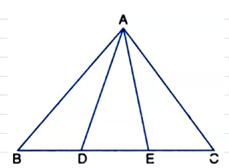In triangle ABC,ifP.Q,R divides sidesBC,AC, and AB, respectively, in the ratio k:1(∈order). If the ratio (arEAPQRareaABC) IS 13,thenk is equal to 13 (b) 2 (c) 3 (d) none of theseSolution in Bengali
1/3
2
3
none of these
The correct Answer is:B
Area of triangle

Area of ΔARQ=b(k+1)×kc(k+1)×12sinA=kΔ(k+1)2
Similarly, area (ΔBPR)= Area of (ΔPCQ)=kΔ(k+1)2
Now, ΔPQRΔABC=13
or Δ−3k(k+1)2ΔΔ=13
or 2k2−5k+2=0
or k=12,2
Topper's Solved these Questions
- BOOK - CENGAGE PUBLICATIONCHAPTER - PROPERTIES AND SOLUTIONS OF TRIANGLEEXERCISE - Multiple correct answer type24videos
PROPERTIES AND SOLUTIONS OF TRIANGLE
- BOOK - CENGAGE PUBLICATIONCHAPTER - PROPERTIES AND SOLUTIONS OF TRIANGLEEXERCISE - Linked comprehension type34videos
PROPERTIES AND SOLUTIONS OF TRIANGLE
- BOOK - CENGAGE PUBLICATIONCHAPTER - PROPERTIES AND SOLUTIONS OF TRIANGLEEXERCISE - Concept application exercise 5.114videos
PROPERTIES AND SOLUTIONS OF TRIANGLE
- BOOK - CENGAGE PUBLICATIONCHAPTER - PROGRESSION AND SERIESEXERCISE - ARCHIVES (NUMERICAL VALUE TYPE )8videos
PROGRESSION AND SERIES
- BOOK - CENGAGE PUBLICATIONCHAPTER - RELATIONS AND FUNCTIONSEXERCISE - All Questions1119videos
RELATIONS AND FUNCTIONS
Similar Questions
The sides of ABC satisfy the equation 2a2+4b2+c2=4ab+2ac Then a) the triangle is isosceles b) the triangle is obtuse c) B=cos−1(78) d) A=cos−1(14)
03:53View SolutionGiven that Δ=6,r1=2,r2=3,r3=6
Circumradius R is equal to a) 2.5 b)3.5 c)1.5 d)none of these04:12View SolutionRegular pentagons are inscribed in two circles of radius 5and 2 units respectively. The ratio of their areas is
00:47View SolutionLet Sk,k=1,2,….100 denote the sum of the infinite geometric series whose first term is k−1K! and the common
ration is 1k then the value of (100)2100!+Σ100k=1|(k^2-3k+1)S_k| is ____________02:10View SolutionIf the function f:[1,∞)→[1,∞) is defined by f(x)=2x(x−1), then find f−1(x)
04:08View SolutionIn triangle ABC,ifP.Q,R divides sidesBC,AC, and AB, respectively, in the ratio k:1(∈order). If the ratio (arEAPQRareaABC) IS 13,thenk is equal to 13 (b) 2 (c) 3 (d) none of these
04:53View SolutionIn a triangle ABC, if a:b:c=3:7:8,thenR:r is equal to a.2:7 b. 7:2 c. 3:7 d. 7:3
06:50View SolutionAny point D is taken in the base BC of a triangle ABC and AD is produced to E, making DE equal to AD. Show that ar (BCE)=ar(ABC)
08:28View SolutionIn Figure DandE are two points on BC such that BD=DE=EC Show that ar(ABD)=ar(ADE)=ar(AEC)
 05:46View Solution
05:46View SolutionABJH, JDEF, ACEG are squares. BCAB=3 . Area BCDJArea HJFG=?
(a) 19
(b) 13
(c) 1
(d) 307:10View SolutionD and E are points on sides AB and AC respectively of ΔABC such that ar (DBC) = ar (EBC). Prove that DE∣∣BC.
03:24View SolutionIn triangle ABC,ifP.Q,R divides sidesBC,AC, and AB, respectively, in the ratio k:1(∈order). If the ratio (arEAPQRareaABC) IS 13,thenk is equal to 13 (b) 2 (c) 3 (d) none of these
04:50View SolutionIf n∑r=1r(r+1)(2r+3)=an4+bn3+cn2+dn+e, then (a) a−b=d−c (b) e=0 (c) a,b−2/3,c−1 are in A.P. (d) (b+d)/a is an integer
03:14View SolutionIn triangle ABC , if AD is the bisector of ∠A , prove that: Area(ABD)Area(ACD)=ABAC
05:21View SolutionIn ABC , AD and BE are altitudes. Prove that ar(DEC)ar(ABC)=DC2AC2
03:31View SolutionIn Figure, PQ∣∣BC and AP:PB=1:2 . Find area(APQ)area(ABC) .
03:07View Solution

